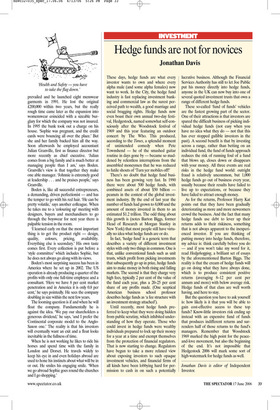Hedge funds are not for novices
Jonathan Davis
These days, hedge funds are what every investor wants to own and where every alpha male (and some alpha females) now want to work. In the City, the hedge fund industry is fast replacing investment banking and commercial law as the surest perceived path to wealth, a good marriage and social bragging rights. Hedge funds now even boast their own annual two-day festival, Hedgestock, named somewhat self-consciously after the Woodstock festival of 1969 and this year featuring an outdoor concert by The Who. This produced, according to the Times, a splendid moment of unintended comedy when Pete Townshend — he of the smashed guitar routine in days gone by — became so maddened by relentless interruptions from the assembled moneymen that he was reduced to futile shouts of ‘Turn yer mobiles off!’ There’s no doubt that hedge fund business has been growing very fast. In 1990 there were about 500 hedge funds, with combined assets of about $50 billion peanuts in the context of the global investment industry. By the end of last year the number of funds had grown to 8,000 and the amount of money invested in them to an estimated $1.2 trillion. The odd thing about this growth is (notes Barton Biggs, former Head of Research at Morgan Stanley in New York) that most people still have virtually no idea what hedge funds are or do.
In fact, ‘hedge fund’ is a generic term that describes a variety of different investment styles with only two things in common. One is that, unlike conventional funds such as unit trusts, which profit from picking investments that subsequently go up in price, hedge funds aim to make money in both rising and falling markets. The second is that they charge very high fees, typically 2 per cent of the value of the fund each year, plus a 20–25 per cent share of any profits made. (One sceptical American business school professor describes hedge funds as ‘a fee structure with an investment strategy attached’).
Until recently, most hedge funds preferred to keep what they were doing hidden from public scrutiny, which inhibited understanding of how they operate. Those who could invest in hedge funds were wealthy individuals prepared to lock up their money for a year at a time and exempt themselves from the protection of financial regulators. That is now starting to change. Regulators have begun to take a more relaxed view about exposing investors to such opaque investment vehicles, and financial firms of all kinds have been lobbying hard for permission to cash in on such a potentially lucrative business. Although the Financial Services Authority has still to let Joe Public put his money directly into hedge funds, anyone in the UK can now buy into one of several quoted investment trusts that own a range of different hedge funds.
These so-called ‘fund of funds’ vehicles are the fastest growing part of the sector. One of their attractions is that investors are spared the difficult business of picking individual hedge funds (not easy when you have no idea what they do — not that this has ever stopped gullible investors in the past). A second benefit is that by investing across a range, rather than betting on an individual fund, the fund of funds approach reduces the risk of running foul of a fund that blows up, closes down or disappears with your money. All three events are real risks in the hedge fund world: outright fraud is relatively uncommon, but 1,000 hedge funds go out of business every year, usually because their results have failed to live up to expectations, or because they have failed to attract enough money.
As for the returns, Professor Harry Kat points out that they have been gradually deteriorating as more and more newcomers crowd the business. And the fact that many hedge funds use debt to lever up their returns adds to their riskiness, something that is not always apparent to the inexperienced investor. If you are thinking of putting money into hedge funds, therefore, my advice is: think carefully before you do — and if you won’t take my word for it, read Hedgehogging, a brilliant set of essays by the aforementioned Barton Biggs. The reality is that the cream of hedge funds will go on doing what they have always done, which is to produce consistent positive returns (averaging 8–12 per cent per annum and more) with below average risk. Hedge funds of that class are well worth having, and here to stay.
But the question you have to ask yourself is: how likely is it that you will be able to gain cost-effective access to these top funds? Know-little investors risk ending up instead with an expensive fund of funds that produces indifferent returns and surrenders half of those returns to the fund’s managers. Remember that Woodstock 1969 marked the high point for the peaceand-love movement, but also the beginning of the end. It’s not impossible that Hedgestock 2006 will mark some sort of high-watermark for hedge funds as well.


















































































 Previous page
Previous page